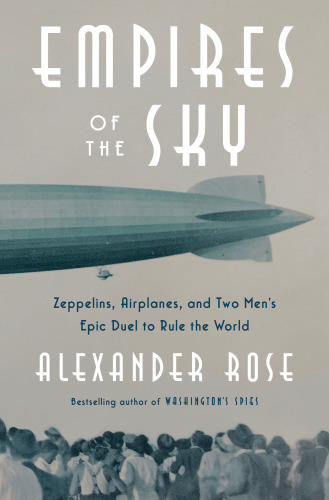
Empires of the Sky
Zeppelins, Airplanes, and Two Men's Epic Duel to Rule the World
کتاب های مرتبط
- اطلاعات
- نقد و بررسی
- دیدگاه کاربران
نقد و بررسی

January 27, 2020
Historian Rose (Men at War) chronicles the early 20th century rivalry between airships and airplanes for the future of commercial air travel in this exhaustive account. Building toward the 1930s showdown between Hugo Eckener, head of Germany’s Zeppelin Company, and Juan Terry Trippe, leader of Pan American Airways, Rose tracks the development of the zeppelin airships and Eckener’s promotion of them as “the silvery herald of global travel” after he took charge of the company from Count Ferdinand von Zeppelin in 1917. Meanwhile, Trippe, a former U.S. Navy pilot, realized that in order to stimulate enough demand to fuel the technological advancements needed to make transatlantic passenger flights possible, an airline needed “to own the exclusive right to operate between given destinations.” He acquired sole landing rights in Cuba, and the first Pan Am flight took off from Key West to Havana in 1927, launching a competition between the industries to win the political and popular support necessary to build fleets and open routes throughout the world. In Rose’s retelling, the fate of the zeppelin was sealed by the rise of the Nazi Party and the 1936 Hindenburg crash, which shifted international interest from airships to airlines. Rose wades deep into minutiae, but maintains a buoyant energy throughout. The result is a dense yet exhilarating history of the dawn of modern air travel.

February 1, 2020
A history of the obsessive pioneers of flight. Bestselling historian Rose (Men of War: The American Soldier in Combat at Bunker Hill, Gettysburg, and Iwo Jima, 2015) emphasizes that when the Wright brothers made the first heavier-than-air flight in 1903, airships had been carrying passengers since the Montgolfier brothers first launched their balloon in 1783. Until well into the 1930s, many entrepreneurs believed that dirigibles--spacious, quiet, capable of flying long distances--were the wave of the future compared with cramped, noisy, accident-prone propeller-driven craft. After a brief account of a successful 1936 flight of the Hindenburg, "the ultimate transoceanic cruiser" that would be destroyed in a spectacular crash just a year later, Rose rewinds the clock to 1863, when German Count Ferdinand von Zeppelin (1838-1917) first flew in a balloon and was inspired. After retirement, he devoted himself to building powered airships, immense craft lifted by flammable hydrogen (helium, much safer, was wildly expensive). He created the world's first commercial airline in 1909. The difficulty of control in bad weather and the danger of hydrogen proved to be insoluble problems. Airships suffered a dismal safety record, although Zeppelin's passenger airline, under his successor, led a charmed life until the Hindenburg disaster. Rose's intriguing second subject does not appear until the author reaches the 1920s, when Juan Trippe (1889-1981) joined other businessmen investing in the first airlines. As the author shows, the competition in the U.S. was already cutthroat, but few airlines existed south of the border, and he began acquiring exclusive rights to fly to the Caribbean and later South America. Flush with profits--from airmail contracts; passengers came later--he persuaded Boeing to develop a flying boat capable of crossing the ocean. The resulting "clippers" became the epitome of glamorous air travel during the 1930s. By 1940, when the book ends, Trippe's Pan American World Airways was the world's largest international carrier, and the Zeppelin was history. Technical and business details dominate the narrative, but the primary story is often riveting. An overlong but still worthy aviation history.
COPYRIGHT(2020) Kirkus Reviews, ALL RIGHTS RESERVED.

March 1, 2020
In the early days of the 20th century, humans first took to the skies in mechanically powered airships. Based on rapidly developing innovations in engineering, the new field of aerodynamics was born, as was the intense competition among the makers of machines capable of flight. Early innovators Count Ferdinand von Zeppelin in Germany and the Wright brothers in the United States were at the center of this rivalry, with each vying for funding, government contracts, local and transatlantic routes, cargo, and passengers. In this fascinating and readable history, author and historian Rose (Washington's Spies; Men of War) recounts the development, growth, and ultimate failures and successes of the two competing technologies, and the business models each spawned. The story is filled not only with myriad facts and figures but also with the well-researched stories of those who participated in the most significant events of the past 100 years. These magnificent men in their flying machines helped to write that history. VERDICT Recommended for general readers who enjoy aviation, technology, and business histories. [See Prepub Alert, 10/7/19.]--Linda Frederiksen, formerly with Washington State Univ. Lib., Vancouver
Copyright 2020 Library Journal, LLC Used with permission.

























دیدگاه کاربران